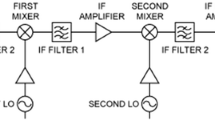Abstract
The S parameter expression of high-frequency models of the high electron mobility transistors (HEMTs) with basic feedback structure, especially the transmission gain S 21, is presented and analyzed. In addition, an improved feedback structure and its theory are proposed and demonstrated, in order to obtain a better gain-flatness through the mutual interaction between the series inductor and the parallel capacitor in the feedback loop. The optimization solution for the feedback amplifier can eliminate the negative impacts on transmission gain S 21 caused by things such as resonance peaks. Furthermore, our theory covers the shortage of conventional feedback amplifiers, to some extent. A wideband low-noise amplifier (LNA) with the improved feedback technology is designed based on HEMT. The transmission gain is about 20 dB with the gain variation of 1.2 dB from 100 MHz to 6 GHz. The noise figure is lower than 2.8 dB in the whole band and the amplifier is unconditionally stable.
Similar content being viewed by others
References
Bahl, I., Bhartia, P., 2006. Microwave Solid State Circuit Design (2nd Ed.). Publishing House of Electronics Industry, Beijing, China, p.366–378 (in Chinese).
Barras, D., Ellinger, F., Jackel, H., Hirt, W., 2004. A low supply voltage SiGe LNA for ultra-wideband frontends. IEEE Microw. Wirel. Compon. Lett., 14(10):469–471. [doi:10.1109/LMWC.2004.834556]
Fu, C.T., Kuo, C.N., Taylor, S.S., 2010. Low noise amplifier design with dual reactive feedback for broadband simultaneous noise and impedance matching. IEEE Trans. Microw. Theory Techn., 58(4):795–806. [doi:10.1109/TMTT.2010.2041570]
Gharpurey, R., 2004. A Broadband Low-Noise Front-End Amplifier for Ultra Wideband in 0.13-μm CMOS. Proc. IEEE Custom Integrated Circuits Conf., p.605–608. [doi:10.1109/CICC.2004.1358898]
Gonzalez, G., 2006. Microwave Transistor Amplifiers Analysis and Design (2nd Ed.). Publishing House of Tsinghua University, Beijing, China, p.366–378 (in Chinese).
Ismail, A., Abidi, A.A., 2004. A 3-10-GHz low-noise amplifier with wideband LC-ladder matching network. IEEE J. Sol.-State Circ., 39(12):2269–2277. [doi:10.1109/JSSC.2004.836344]
Kim, C.W., Kang, M.S., Anh, P.T., Kim, H.T., Lee, S.G., 2005. An ultra wideband CMOS low-noise amplifier for 3-5-GHz UWB system. IEEE J. Sol.-State Circ., 40(2): 544–547. [doi:10.1109/JSSC.2004.840951]
Lee, J., Cressler, J.D., 2005. A 3–10 GHz SiGe Resistive Feedback Low Noise Amplifier for UWB Applications. IEEE Radio Frequency Integrated Circuits Symp., p.545–548. [doi:10.1109/RFIC.2005.1489871]
Li, Q., Zhang, Y.P., 2007. A 1.5-V 2-9.6-GHz inductorless low-noise amplifier in 0.13-μm CMOS. IEEE Trans. Microw. Theory Techn., 55(10):2015–2023. [doi:10.1109/TMTT.2007.905495]
Park, Y., Lee, C.H., Cressler, J.D., Laskar, J., Joseph, A., 2005. A Very Low Power SiGe LNA for UWB Application. IEEE MTT-S Int. Microwave Symp., p.1041–1044. [doi:10.1109/MWSYM.2005.1516847]
Roy, S., Foerster, J.R., Somayazulu, V.S., Leeper, D.G., 2004. Ultrawideband radio design: the promise of high-speed, short-range wireless connectivity. Proc. IEEE, 92(2):295–311. [doi:10.1109/JPROC.2003.821910]
Scholtz, R.A., Weaver, R., Homier, E., Lee, J., Hilmes, P., Taha, A., Wilson, R., 2000. UWB Radio Deployment Challenges. 11th IEEE Int. Symp. on Personal, Indoor and Mobile Radio Communications, p.620–625. [doi:10.1109/PIMRC.2000.881497]
Wang, H., Dow, G.S., Allen, B.R., Ton, T.N., Tan, K.L., Chang, K.W., Chen, T.H., Berenz, J., Lin, T.S., Liu, P.H., et al., 1992. High-performance in W-band monolithic pseudomorphic InGaAs HEMT LNA’s and design/analysis methodology. IEEE Trans. Microw. Theory Techn., 40(3): 417–428. [doi:10.1109/22.121716]
Win, M.Z., Scholtz, R.A., 1998. Impulse radio: how it works. IEEE Commun. Lett., 2(2):36–38. [doi:10.1109/4234.660796]
Xie, H.Y., Zhang, W.R., Li, J., Shen, P., Huang, Y.W., Huang, L., Hu, N., 2009. Study of Feedback Technology for Gain Flatness of UWB LNA. 3rd IEEE Int. Symp. on Microwave Antenna, Propagation and EMC Technologies for Wireless Communications, p.466–469. [doi:10.1109/MAPE.2009.5355634]
Zhan, J.H.C., Taylor, S.S., 2006. A 5GHz Resistive-Feedback CMOS LNA for Low-Cost Multi-standard Applications. IEEE Int. Solid-State Circuits Conf., p.721–730. [doi:10.1109/ISSCC.2006.1696111]
Author information
Authors and Affiliations
Corresponding author
Additional information
Project supported by the Guangdong Key Technologies R & D Program (No. 2007B010400009) and the Guangzhou Science and Technology Pillar Program (No. 2008Z1-D501), China
Rights and permissions
About this article
Cite this article
Li, Zh., Guo, Bh., Wei, Zj. et al. A gain-flatness optimization solution for feedback technology of wideband low noise amplifiers. J. Zhejiang Univ. - Sci. C 12, 608–613 (2011). https://doi.org/10.1631/jzus.C1010300
Received:
Accepted:
Published:
Issue Date:
DOI: https://doi.org/10.1631/jzus.C1010300




